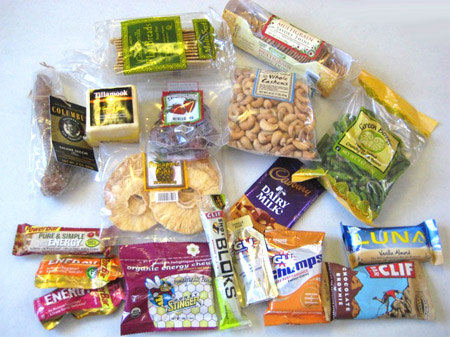TECH TIP: Snack Lunch Food
By Bela G. Vadasz
Don't Try This At Home!
To best accommodate different tastes and needs, it works well for each member of a climbing team to select, measure and pre-package their own lunch food. We need to calculate carefully, especially on multi-day trips, when weight and bulk become an issue. Here are some important considerations for choosing and packing your lunch food:

Some of the Director's favorites to choose from.
A small amount should pack a lot of punch
Choose food with plenty of caloric value. Shoot for about 1500-1800 calories per day for your snack lunch food. We usually count on another 1500 or so for breakfast and dinner combined. Think of the food values as quick-burning to give you fast energy and slow burning, like a time-release tablet. Different than daily food back home, carbohydrates are great for the quick energy and fats and protein is the theme for the long haul.
Keep in mind that fats and protein can get harder to digest at higher altitudes. Sometimes we go with more fats and protein lower on the mountain. Then, up high, more carbohydrates replace the protein and fat. Just need to re-nourish more often so it needs to be convenient and easy to get to, even on the move, if necessary.
Unlike back home when we often stop for a lunch break and have a full meal in one sitting, we often snack throughout the day instead. It's the best way to keep our energy up throughout the full, active day. We may start snacking at 10:00am, have a chunk of the day's ration in the middle of the day, but still keep snacking in the afternoon to keep from bonking. We call it, "grazing" through the day. I often find when I arrive at camp, I only ate about ½-3/4 of my food for the day. Then, I'll sit down, replenish and have the rest. That will hold me until dinner and help with recovery.
Calculate, measure and prepackage
Choose your amounts, usually by weight estimations. Pick items that will hold their form in the heat or won't freeze rock solid to break your teeth in the cold. Use zip-lock bags to separate your day's portions. Fold them flat when you are done. Save them and reuse them for your next trip. This system helps you understand your portions and rations. It keeps excess wrappers from getting loose in the mountains.
Fresher foods on shorter trips
On one-day trips or on the first day of a multi-day trip, go ahead and bring a fresh bagel instead of crackers and an apple and orange instead of dried fruit. For just the day, you can afford weight and the bulk.
Protein sources
Salami & cheese sure packs a caloric and fat punch. If it's not in your taste preference, think of alternatives you like, maybe dried salmon, turkey jerky, peanut butter and honey on hearty Wheat Berry bread, pre-cut into mini-squares. Baked tofu will last a few days out of the refrigerator and can be a tasty alternative. Remember, harder cheeses will also keep longer than softer cheeses.
Power Products
Power Bars, Goo gels, Snickers bars, chocolate bars with nuts are usually excellent for quick energy, but also with some fat and protein for the time-release. Find ones you like, calculate what you need in relationship to everything else you're bringing and keep them handy to get to at short breaks.
Remember, it's not the time to be on a weight loss diet by not bringing food. You'll lose plenty of weight anyway. You need to keep your energy up. It's a safety issue too!
The following is our long standing, time-tested lunch food guideline. Choose your items, calculate your quantities and have fun prepping your food!

Here is a suggested snacklunch sample we would carry for 1 day:
Lunch-high energy, snackable type
-3 oz. protein source (cheese, dried meat or other)
-2-3 oz. crackers or light bread or bagel
-2 oz. mixed nuts
-2 oz. dried fruit
-2 Energy bars such as Power Bar, Cliff Bar or Nature Valley (sweet & salty almond)
-1 instant drink mix per day (optional)
Measure and prepackage your food carefully.

|